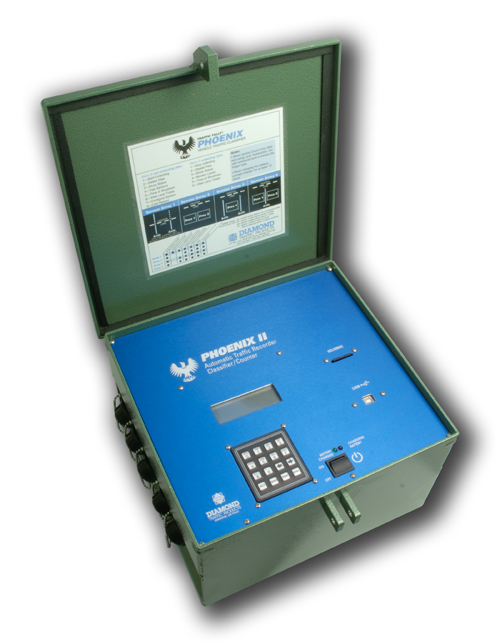|
Count methods include directional, lane subtraction, and normal.
Using any of three primary different data types the Phoenix II can record data for classification. Class data can be collected in the following data storage types:
- Binned – The most common data collected, binned allows for vehicles to be sorted into user defined bins of axles, speed, length headway and gap with a total of 30 bins per type depending on sensor configuration.
- Per Vehicle Raw – Each vehicle record is stored with the following attributes:
- Lane # - Time – Speed – Axles and Spacings – Overall Length
- Time Stamped Sensor - This is the most basic of data types that will store sensor activations to allow for classification and sensor processing to be done post collection with PC software. While providing the most flexible data, sensor timestamp uses the most memory when collecting data.
- Temperature an Battery Data Storage
When in collection mode the Phoenix II can be set to store temperature data and battery voltage data changes along with the count/class data in the counter files for later processing.
The Phoenix II unit includes an advanced feature for dual count and class operation to allow for count and class data to be collected simultaneously. This feature enables the unit to account for sites that may have some lanes that are functioning as classification and others that are not (ex: bad sensors eliminate the ability to classify vehicles in one or more lanes).
- Record interval lengths from 1min to 24hr
The classifier can be programmed to use different interval lengths to record data. The following interval lengths are available:
1min, 2min, 5min, 10min, 15min, 30min, 1hr, 2hr, 4hr, 6hr, 12hr, 24hr(1day)
- Onboard keyboard and LCD display
The 4 line 20 character per line LCD display allows real time vehicle data monitoring and programming of the unit via the 16 key alpha-numeric watertight keypad.
- Dynamic Sensor assignment and calibration
Sensor assignment and calibration can be changed in the Phoenix II unit by the user on site or via telemetry to account for failing sensors or incorrect input of signals. This also allows for changing lane sensor configurations to accommodate sites with different lane setups.
|
- Ultra Low power consumption with Smart Power Management
Designed for use in remote areas and urban sites alike, the Phoenix II can operate off very low power draw making it a viable solution for data collection with solar or ac/dc power source. The classifier also has smart power management to account for loss of power without losing data and providing auto reinitializing when power is restored to allow for the maximum up time in power event failures. In the event of power loss from a solar or AC power source, the unit has a 6 volt internal battery that can sustain operation for up to 7 days.
- Built In Surge and RF protection
With the advent of advances in telecom and electronic protection circuitry, the Phoenix II provides built in grounding protection to be hardened against lightning, noise, and RF interference from sensors. With a separate grounding strap for protection the Phoenix II is designed for the highest reliability and up time in permanent locations with redundant protection circuitry.
- Modem and Serial Telemetry
With an onboard RS232 port and optional 2 and 3 port functionality, the Phoenix II provides real time data output and allows for remote telemetry via external modems with a serial interface.
- USB Peripheral connection
An optional USB peripheral port can be installed on the Phoenix II for direct connection to a laptop, PC or other USB host for communication.
Incident detection provides the classifier real time monitoring of traffic parameters and sensor conditions. With incident detection the classifier can be programmed to report sensor failures, specific traffic conditions or warnings to a central office (via modem) and to local warning sings or VMS systems.
The Phoenix II includes 1MB onboard battery backed up RAM memory. An optional 32MB – 1GB MMC/SD card expansion slot is available for either internal permanent or front panel removable memory.
Loop x Space, is a way to extend vehicles past the end of the final loop
activation. This function is particularly useful when poor loop conditions cause a loop to prematurely drop out and result in two vehicles being reported instead of one.
|



 The article has been updated successfully.
The article has been updated successfully.

